
Andersonia is a genus of mostly small, evergreen shrubs in the family Ericaceae and is endemic to the Southwest Botanical Province in Western Australia.
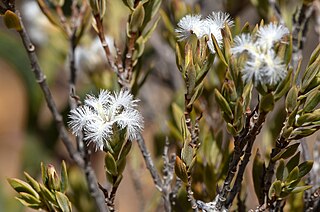
Leucopogon foliosus is a species of flowering plant in the heath family Ericaceae and is endemic to the south-west of Western Australia. It is a low, spreading shrub with hairy young branchlets, spirally arranged, erect, linear, narrowly egg-shaped to narrowly elliptic leaves, and white, narrowly bell-shaped flowers.
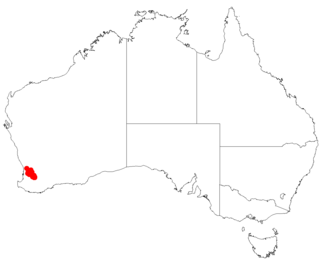
Leucopogon darlingensis is a species of flowering plant in the heath family Ericaceae and is endemic to the south-west of Western Australia. It is an erect shrub with hairy young branchlets, spirally arranged, linear, oblong, narrowly elliptic or narrowly egg-shaped leaves and white, bell-shaped flowers arranged in upper leaf axils and at the ends of branches.
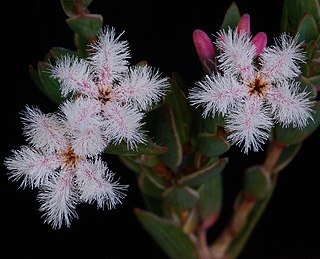
Leucopogon elegans is a species of flowering plant in the heath family Ericaceae and is endemic to the south-west of Western Australia. It is a spreading shrub with egg-shaped leaves, and white or pink, tube-shaped flowers densely bearded on the inside.
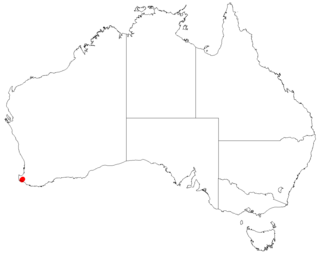
Leucopogon incisus is a species of flowering plant in the heath family Ericaceae and is endemic to a small area in the far south of the south-west of Western Australia. It is a delicate, erect or sprawling shrub with glabrous young branchlets, spirally arranged, erect, narrowly egg-shaped to narrowly elliptic leaves, and white or pale pink, narrowly bell-shaped to more or less cylindrical flowers.
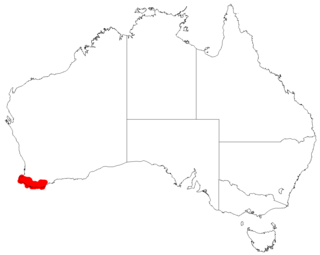
Leucopogon interstans is a species of flowering plant in the heath family Ericaceae and is endemic to the south-west of Western Australia. It is an erect shrub with brownish hairs on its young branchlets, erect, narrowly elliptic or narrowly egg-shaped leaves and white or pinkish flowers in groups in upper leaf axils or on the ends of branches.

Leucopogon microcarpus is a species of flowering plant in the heath family Ericaceae and is endemic to the southwest of Western Australia. It is a low, compact shrub with hairy young branchlets, narrowly elliptic, narrowly egg-shaped or linear leaves and erect, compact clusters of 3 to 9 white, tube-shaped flowers in upper leaf axils or on the ends of branches.

Leucopogon subsejunctus is a species of flowering plant in the heath family Ericaceae and is endemic to a restricted area in the south-west of Western Australia. It is an erect shrub with hairy young branchlets, spirally arranged, narrowly egg-shaped or narrowly elliptic leaves, and white, bell-shaped flowers with a pink tinge.
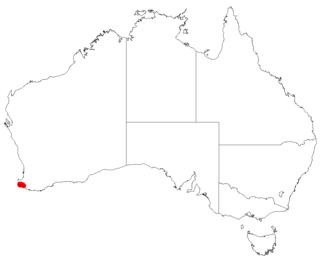
Leucopogon wheelerae is a species of flowering plant in the heath family Ericaceae and is endemic to the far south-west of Western Australia. It is a sprawling shrub with slender, glabrous young branchlets, more or less erect, egg-shaped or broadly egg-shaped leaves, and white, broadly bell-shaped flowers with white or pale pink lobes.

Styphelia capillaris, commonly known as Horts' styphelia, is a species of flowering plant in the heath family Ericaceae and is endemic to a small area of south-western Western Australia. It is a dense, spreading shrub with narrowly egg-shaped to narrowly elliptic leaves and white flowers arranged singly or in pairs in leaf axils.
Styphelia angustiflora is a species of flowering plant in the heath family Ericaceae and is endemic to a small area near York, in the south-west of Western Australia. It is an erect, compact shrub with sharply-pointed, narrowly egg-shaped leaves and white, tube-shaped flowers.
Styphelia oblongifolia is a species of flowering plant in the heath family Ericaceae and is endemic to the south-west of Western Australia. It is an open or straggling shrub with erect, narrowly oblong leaves and pale yellow, tube-shaped flowers.
Styphelia quartzitica is a species of flowering plant in the heath family Ericaceae and is endemic to a small area in the south of Western Australia. It is an erect shrub with hairy young branchlets, sharply-pointed, linear or very narrowly egg-shaped leaves, and cream-coloured, tube-shaped flowers.
Andersonia annelsii is a species of flowering plant in the family Ericaceae and is endemic to a restricted part of the southwest of Western Australia. It is a low shrub with egg-shaped to round leaves and white, tube-shaped flowers.

Andersonia aristata, commonly known as rice flower, is a species of flowering plant in the family Ericaceae and is endemic to the southwest of Western Australia. It is a slender, erect or spreading shrub with linear to lance-shaped leaves and white, tube-shaped flowers with bearded petal lobes.
Andersonia barbata is a species of flowering plant in the family Ericaceae and is endemic to the south-west of Western Australia. It is an erect shrub with slightly twisted, lance-shaped leaves, and blue flowers.

Andersonia brevifolia is a species of flowering plant in the family Ericaceae and is endemic to the south-west of Western Australia. It is an erect shrub with egg-shaped leaves and white or pink flowers.
Andersonia ferricola is a species of flowering plant in the family Ericaceae and is endemic to a restricted part of the southwest of Western Australia. It is a straggling shrub with twisted, narrowly egg-shaped leaves and pale lilac, tube-shaped flowers.
Andersonia geniculata is a species of flowering plant in the family Ericaceae and is endemic to the southwest of Western Australia. It is a low, spreading shrub with twisted, linear or very narrowly egg-shaped leaves and white, tube-shaped flowers.

Andersonia heterophylla is a species of flowering plant in the family Ericaceae and is endemic to the south-west of Western Australia. It is an erect or ascending shrub with egg-shaped to more or less linear leaves and white or pink flowers.














